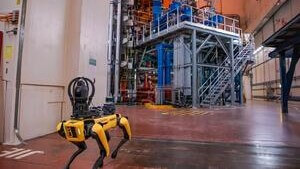Autonomous Robot Successfully Deployed For Fusion Facility Inspections In World-First Trial

For the first time, an autonomous robot has been successfully deployed to carry out inspections at a fusion facility, marking a significant step forward for the use of robotics in challenging environments.
The 35-day trial took place at the United Kingdom Atomic Energy Authority (UKAEA)’s Joint European Torus (JET) facility, one of the largest and most powerful fusion research centres, now in the process of decommissioning following its operational shutdown. The project was conducted in collaboration with the Oxford Robotics Institute (ORI).
Dr. Robert Skilton, head of research at UKAEA’s Remote Applications in Challenging Environments (RACE) division, said the trial aimed to demonstrate the reliability and safety of autonomous robots in performing extended inspection tasks. “The project aimed to validate the reliability of autonomous robotic technology and instil trust and confidence in their use for safe and efficient inspections in fusion facilities over extended periods,” Skilton stated.
The deployment involved the use of ORI’s AutoInspect platform, controlling a Boston Dynamics Spot quadruped robot. The robot was tasked with inspecting JET, which remains a hazardous environment following two high-powered deuterium-tritium experiments in recent years. Spot was able to map the entire facility, take environmental sensor readings, and navigate obstacles and personnel involved in the ongoing decommissioning process.
UKAEA’s inspection payload was integrated with ORI’s localisation and mission autonomy solutions, which were paired with Boston Dynamics’ hardware and collision avoidance systems. The robot collected critical data on JET’s status and environment twice daily.
Dr. Skilton highlighted the benefits of using autonomous robots in such settings, noting that the trial demonstrated their potential to improve safety and reduce costs. “These ‘next generation’ solutions are becoming ready to be used in other industrial facilities such as nuclear decommissioning, environmental clean-up, and disaster relief,” he added.
Nick Hawes, Professor of AI & Robotics and director of ORI, echoed this sentiment: “Projects like this demonstrate the value of autonomous robots. They also ground our science in real use cases and provide requirements and constraints that drive us to invent new AI and robotics algorithms.”
This project was supported by the Engineering and Physical Sciences Research Council through the Embodied Intelligence: From Sensing to Collaboration programme grant, which focuses on creating autonomous systems that enhance human capabilities.
The results from this trial will help shape the next stages of the JET decommissioning and repurposing (JDR) programme, demonstrating the practical application of autonomous robots in complex and hazardous industrial environments.
Image: Spot returning after deployment at UKAEA’s Joint European Torus (JET) facility (Credit United Kingdom Atomic Energy Authority).




